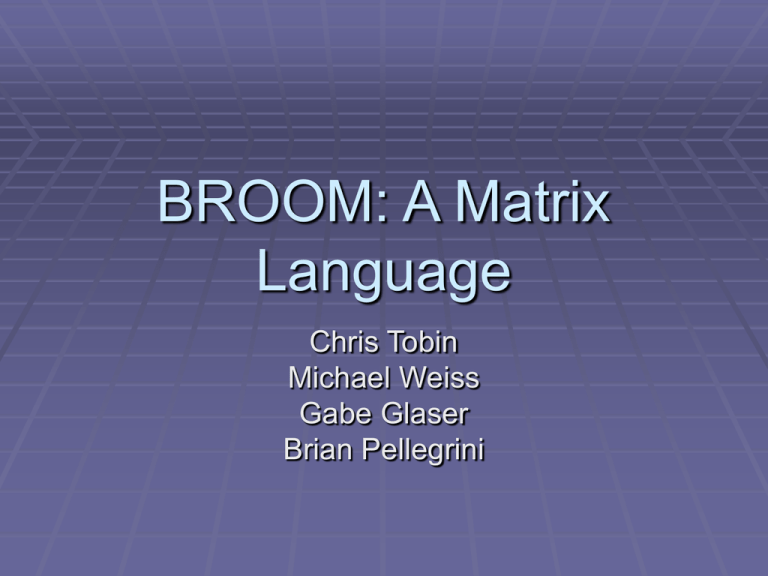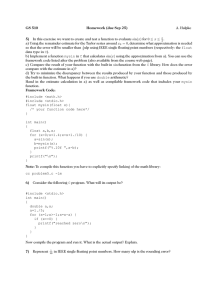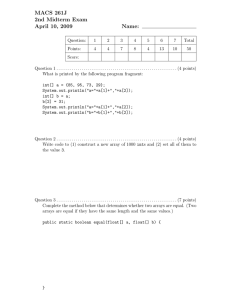BROOM: A Matrix Language Chris Tobin Michael Weiss
advertisement

BROOM: A Matrix
Language
Chris Tobin
Michael Weiss
Gabe Glaser
Brian Pellegrini
Broom Overview and Summary
A high-level language for manipulating
matrices
Many useful built in matrix operations.
Ability to define and build more
complicated functions for specialized
analysis of information
Motivation
Matrices are universal mathematical
constructs
Learning curve is not as steep
Specialized use, without extraneous things
to understand other than
what you need it for.
No need for expensive software
Goals
Intuitive syntax
High level
Very portable
Flexible
Useful and informative error checking
Broom Syntax
Intuitive
for ( ) … endfor
Freeform
whitespace inserted at will
Smooth built-in matrix operation syntax
A = inv(B); // finds the inverse of B
Features:
Control flow constructs: for, while, if
Nested logical operators and expressions
A wide range of built-in functions
Built-in Functions
Many useful built-in function calls:
det
colswap, rowswap
inv
gauss
appendUD, appendLR
setCol, setRow
Too numerous to list…22 total
Semantics
Broom features:
Function definitions
Allow for modularity, power, and reusable code.
Variable definitions
Two intuitive mathematical types
Number
Matrix
Scoping rules:
local – for functions
global – accessible by all
All functions call-by-value for simplicity
Compiler Components and
Composition
There are 5 main components of BCC, the
Broom translator
Lexer
Parser
Static Semantics Checker
W/Symbol Tables
BroomMatrix.java
Contains Matrix manipulation code and functions
Code Generator
ANTLR
The Lexer and Parser were implemented using
ANTLR.
ANTLR’s AST class was used to create the Abstract
Syntax Tree and Nodes.
The Static Semantics Checker was
implemented as a TreeWalker of the ANTLR
AST and maintained Symbol Tables for the
various scopes.
Symbol Tables were written as a simple Java class
Code Generator was also implemented as a
TreeWalker of ANTLR AST.
Accumulates a “program string” as it walks the AST
and prints string to file upon finishing traversal
Block Diagram of Compiler
Example of Generated Code
MyProgram.broom:
MyProgram
global Matrix myMatrix;
myMatrix = [1,2;
3,4;];
//function definitions here...
start()
Number value;
value = det( myMatrix *
[1,3;
7,8;]);
//print the value you got
value.print();
//print the global Matrix
myMatrix.print();
endstart
MyProgram.java
public class MyProgram
{
BroomMatrix myMatrix;
public MyProgram()
{
float[][] _temp0 = {{(float) 1,
(float) 2}, {(float) 3, (float) 4}};
myMatrix = new BroomMatrix( _temp0);
}
public void start()
{
float value;
float[][] _temp1 = {{(float) 1,
(float) 3}, {(float) 7, (float) 8}};
value =
BroomMatrix.det(BroomMatrix.multiply(m
yMatrix, new BroomMatrix( _temp1)));
BroomMatrix.printVariable(value);
BroomMatrix.printVariable(myMatrix);
}
public static void main(String[] args)
{
MyProgram myProgram = new MyProgram();
myProgram.start();
}
}
Output of The Simple Program
$ javac MyProgram.java
$ java MyProgram
26.0
1.0 2.0
3.0 4.0
Error Checking
Two main types of errors
Semantic Errors
Invalid use of logical ops
Invalid type assignments
Use of reserved words as variable names, etc.
Run-Time Errors
Reference to non-existent index
Use of improperly formatted matrix.
*Note: If “de ja vu” is experienced something in your
matrix may have been changed.
Example Test Program
wrongNumColls
// Test for number of columns errors
// Author Brian Pellegrini
// This is supposed to make sure that error checking for
//assignment of matrix values works...it is supposed to fail
// MUA HAHAHHAHAHHAH
global Matrix A,B;
A= [1, 0, 1; 0, 1;];
B= [0, 1; 1, 0 , 2;];
start()
print ("If this printed checker didn't work");
endstart
Example Test Results
BroomProgram did not compile; the following errors were detected:
* Error in *global declaration* : invalid matrix specification.
Expected a row with 3 elements, but got 2
Error in *global declaration* : invalid matrix specification.
Expected a row with 2 elements, but got 3
BROOM compiler found all the errors!
During testing one has to be careful that errors being tested are
the only ones present in the program
Inadvertent bugs can cause lots of lost time spend debugging
“ghost bugs”
Lessons Learned
Leave no stone unturned
Need to test every possible error user might
encounter
Need to test both errors in user’s code, and errors in
generated JAVA code
Exhaustive testing pays off in the end
Have someone else try it!
Have a friend write a program, they might find errors
that the testing team simply overlooked.







